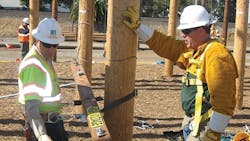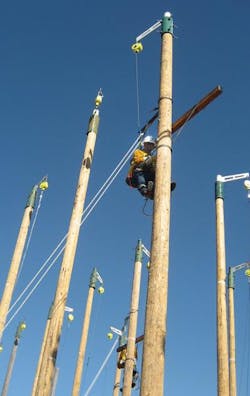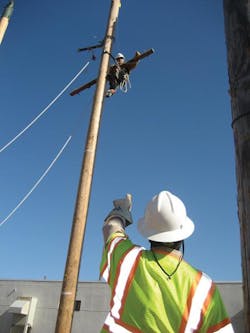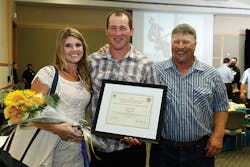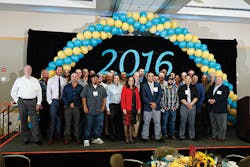Through a program called Linemen 2000, Pacific Gas and Electric Co. (PG&E) once hired its field workforce with no experience and then focused primarily on on-the-job training. To give its field workforce more rigorous training, the utility revamped its apprenticeship program six years ago to develop the most proficient and safest line workers in the industry.
The first class of linemen to complete the new program recently graduated. In total, 28 apprentices walked across the stage to receive their certificate of completion at the ceremony in San Ramon, California.
These new graduates successfully completed 51 days of formal training as pre-apprentices followed by 151 days of formal training and 5040 hours of on-the-job training as apprentices. In the past, apprentices only had 42 days of formal training throughout the entire 42-month program.
Screening Candidates
Rather than trying to find applicants from across the U.S., PG&E tries to go local by finding prospective apprentices in local areas and communities. In general, the utility searches for applicants with a strong interest in the trade and who want to work with their hands. After reviewing thousands of applications, PG&E brings a select group in for a four-hour assessment.
During this screening process, the applicants participate in five different assessments:
• Applicants climb a stepped pole with a harness and retractor so the utility can determine whether they have a fear of heights, and whether they are comfortable with being on and working on poles.
• Applicants install an insulator from an aerial lift elevated to about 55 ft.
• Applicants haul a crossarm with a hand line to the top of the pole, hold it in position for 20 seconds and then let it down under control to test their overall body strength.
• Applicants then install the crossarm on a stepped pole at ground level so the utility can assess whether they have the necessary upper body strength.
• Applicants are asked to follow a series of instructions in proper sequence to test for simple memory retention.
Next, PG&E lines up those who pass for an interview, ranks them and offers them positions as they become available. Then, through its new pre-apprenticeship program, PG&E further screens applicants to ensure they are in the right trade, physically fit and willing to perform the work of a lineman.
Pre-Apprenticeship Program
On their first day, the new hires report to the new employee orientation and then to their technical training. The first 32 days prepare them to arrive on a crew and immediately be able to perform routine work tasks without being a production burden or a safety risk.
When leaving the pre-apprenticeship program, the new apprentices are fully trained, are competent to handle a variety of different work assignments and serve as a groundman on an electrical line crew. As one apprentice stated, they are able to get really good at their ground game before stepping into the apprenticeship.
As a result of the initial training, journeymen are more engaged with the pre-apprentices and apprentices, and they provide valuable feedback on a daily basis to drive a performance in alignment with the crew and utility expectations.
Apprenticeship Program
When apprentices enter the next phase of their training — the formal apprenticeship — they attend classroom and field training sessions at PG&E’s Livermore training center. During this time, they will learn how to do all aspects of line work.
In the first year, they start off with four weeks of overhead construction followed by advanced driving and four weeks of underground construction — all of which is spaced out over time and supported by thousands of hours of on-the-job experience and on-the-job training. Before transitioning from each six-month increment of time, the apprentices are required to take a step-progression test. This accumulative knowledge and skills assessment enables them to demonstrate they can perform and retain all the critical knowledge and skills on which they have been trained.
During the second year, they attend a three-week course on transmission and grounding followed by a three-week course on rubber gloving up to 5 kV and on live-line tools. The third and fourth years include four weeks of advanced overhead rubber gloving up to 21 kV, 13 days of advanced underground, four days of comprehensive excavator, and three days of coaching and mentoring.
Training in the Field
Apprentices move through eight steps (in six-month increments) over the course of four years. During this time, field training coordinators work with the instructors, field supervisors and apprentices to ensure the apprentices are exposed to the work that corresponds to the training they just completed.
Over time, PG&E has learned this is more effective and creates less variation of results. For example, they may receive one day of formal training on how to wire transformers, but if they are not exposed to it for four to six months, they will forget what they learned unless assigned to work that reinforces the learned task.
This process of formal training followed up by on-the-job experience extends the perish curves significantly and enables apprentices to maintain competency for longer periods of time. After completion of apprentice training, successfully passing the journeyman exam and topping out, apprentices are capable of safely performing all aspects of line work required to maintain the PG&E T&D system.
Revising the Program
PG&E has made significant changes to how its employees climb poles and, as a result, had to make significant changes to its training program. For example, prior to 2008, PG&E was a free-climbing utility much like many other utilities across the U.S. In 2008, PG&E transitioned to 100% attachment and began exploring and testing many different tools as well as work procedures, which fundamentally changed how the linemen climb wood pole structures.
As a result of a partnership with International Brotherhood of Electrical Workers Local 1245, PG&E and its members settled on work procedures and tools that increase linemen safety and prevent them from falling off poles. Training expanded from 10 days of climbing in the apprentice program to more than 20 days of climbing in the pre-apprentice program, making candidates fully competent climbers before they enter the apprentice program. PG&E has seen success rates in climbing go from 65% to 90% success since implementation.
Other significant changes include defensive-driving programs, heavy equipment operation including a Class A license, and use of technologies in and out of the classroom. During the defensive driving program, apprentices learn how to maneuver and maintain control of the vehicle, back up safely, conduct blind spot surveys on their vehicles, and maintain traction on wet and icy roads while driving a skid car and skid truck.
In addition, the apprentices learn how to use technology effectively in the field. For example, PG&E issues iPads to all for their technical content training and knowledge assessments. The apprentices also practice their skills in interactive classrooms, which contain different types of simulators. For example, PG&E has equipped its classrooms with a wiring transformer simulator from 3D Internet and a heavy equipment simulator from Caterpillar.
Seeing Results
PG&E has experienced positive results since redesigning its apprentice program, with 92% of candidates successfully completing the program. The apprentices are proving to be productive and safe, and are driving business results in a favorable direction.
PG&E now has the confidence to hire in a manner that meets its stated hiring needs and provides its customers with safe, reliable and affordable energy. In 2016, PG&E will graduate 125 apprentices and keep pace to hire and graduate about 60 a year for the next three years to five years.
PG&E and IBEW 1245 continue to partner together to build and maintain a best-in-class apprentice program of which its fellow tradesman can be proud.
Dan Amour is senior manager of strategic training program development for PG&E. He started line work in 1985 as part of the U.S. Air Force and then joined PG&E 20 years ago. After working as a lineman and in general construction, he moved into the training department in 2000 and has been training linemen and building a best-in-class apprentice program ever since.
Editor’s note: Visit the PG&E website to view a video about the PG&E training program.
